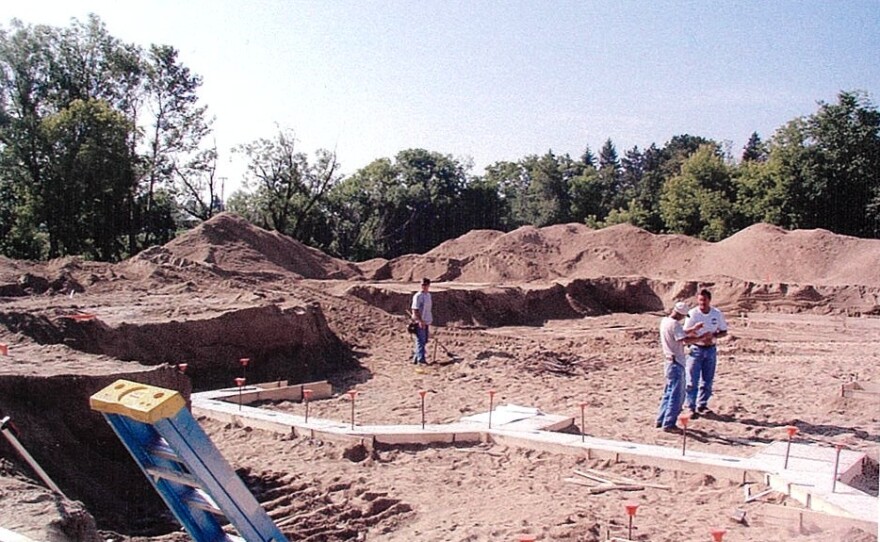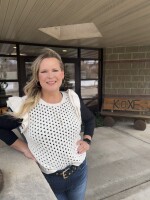Public media is making headlines lately with scrutiny on government funding and misconceptions about how nonprofit radio like KAXE operates.
Here's the truth: Since 1976, KAXE has served the communities of rural Northern Minnesota with independent community radio, powered by people.
Right now, it is more important than ever to understand how KAXE operates.
KAXE is launching Unplugged, a series to share our story — why we exist, how we are funded, who makes decisions and why public radio in Northern Minnesota is essential.
Our story begins
In 1976, a group of passionate people believed Northern Minnesota deserved a voice — a radio station to reflect the region's unique culture, values and stories. The effort took a few years to get going, and the Corporation for Public Broadcasting, or CPB, hesitated early on. The concern was that public radio would not appeal to rural people. They said KAXE would be broadcasting to a bunch of gophers.
Boy, have we proven them wrong.
Through this vision of connecting people in small towns, KAXE was born, becoming the first rural community-owned radio station in the United States. Our humble beginnings were fueled by determination, grassroots support and a deep connection to the people and places of Northern Minnesota.
The early days brought a small team with big dreams, broadcasting from modest facilities at Itasca Community College. What KAXE lacked in resources, we made up for in heart. No matter how sweaty and stinky and cramped it was at KAXE, the mission was always clear: create a platform where local voices could be heard, local music celebrated and local issues discussed openly.
Listen to the Morning Show conversation above about federal funding cuts impact on KAXE
KAXE expanded broadcast reach as well, operating translators in both Bemidji and Brainerd.
Evolving to meet community needs
In 2005, KAXE transformed to meet the community’s changing needs. We raised funds from individuals and grants from local foundations to build our own studio on the banks of the Mississippi River in Grand Rapids. The new physical space of KAXE reflected our deep connection to the region and the natural world.
Suddenly, the larger community became a tangible part of who we were: from local art to locally sourced stone and woodworking, as well as the space to comfortably welcome guests and volunteers to broadcast and host the community for conversation. Not to mention the iconic views of the mighty Mississippi outside the windows.
In 2012, KBXE was born, expanding west to include a second studio in beautiful downtown Bemidji, broadening our reach once again and strengthening our ability to serve Northern Minnesota. The mission remained the same — serve Northern Minnesota with authentic, community-focused content.
In a bustling downtown setting, the new location was now an additional welcoming artistic space for the community and guests. With the expanded studio, the number of volunteer music hosts grew by leaps and bounds with the new option of broadcasting in either Bemidji or Grand Rapids.
Aside from hearing from community members in Grand Rapids and Bemidji, on KAXE you’ll hear folks from Brainerd, Crosby, Calumet, Park Rapids, Cass Lake, Virginia and Bigfork, along with many other small towns. We’re committed to reaching a broad geographic area across Northern Minnesota.
Today, we’re more than just radio. While we continue to report, broadcast and live here, we have also expanded our reach beyond traditional radio.
Our website streams our live broadcast as well as in-depth local news, music information and community conversations, original content is shared through podcasts like Phenology and the Up North Report, and weekly newsletters keep our community informed. We believe in meeting people where they are — whether on the radio, their email inbox or on-demand through digital platforms.
KAXE is proud of the fact that in just the last few years, we've built a solid, trusted news department that has made great impacts in our communities. From local election information not available anywhere else, to economic development in small towns as a cannabis industry in Minnesota emerges, our news team is expanding what we offer to the community. This has led to our website visits rising markedly, leading to more and more people seeing the resources and information we bring to the community.
We're not outsiders looking in; we're your neighbors, friends and fellow community members. The staff and volunteers care about the people and the land of Northern Minnesota.
In addition to staff, community members are on the air throughout KAXE's broadcast day — with trained volunteer hosts producing 70 hours of programming per week.
We are community-owned and listener-powered
KAXE is independent — funded by our community. But what's our biggest source of funding?
Our community.
Support from our members and local businesses keeps us on the air. While we also receive grants from local and regional foundations, as well as from the state of Minnesota and federally from the CPB, these entities have never dictated our content. Our editorial decisions have never and will never be influenced by advertisers, political interests or government entities.
We answer to you.
The stories we tell, the music we play, and the conversations we have are all shaped by listener feedback and community involvement.

Who’s our boss?
We’re not part of a larger entity like Minnesota Public Radio. While we buy programming and are an affiliate of National Public Radio and Ampers (a Minnesota consortium of small public stations not part of MPR), these organizations have ZERO say or editorial control over our content.
Our independence allows KAXE to focus entirely on serving our community without outside influence.
KAXE has been listener-powered since 1976, and that’s not changing. Our long-standing roots in Northern Minnesota are strong because of our members — people like you, who believe in the power of independent media.
We believe rural people deserve media that reflects them.
As one member recently said on the Friday KAXE Morning Show segment What’s for Breakfast: “I think that no matter what kind of program you guys do, how slick your production values get, you never lose sight of where it started and why you are there: it’s the community. That’s why we hang in there with you.”
How we’re funded
KAXE relies on a diverse funding model that reflects the broad support we receive from our community. Here’s how our funding breaks down for Fiscal Year 2023:

- Individual Contributions: 22.08%
- Underwriting from Local Businesses: 11.69%
- CPB Federal Grants: 12.97%
- State of MN General Fund Grant: 5.66%
- State of MN Legacy Grant: 15.37%
- Other Grants (Blandin Foundation, McKnight Foundation and Northland Foundation): 26.03%
- Special Events: 0.28%
- Endowment Income: 1.20%
- Miscellaneous & Interest Income: 4.73%
This diverse funding structure ensures our sustainability while maintaining our independence. Individual contributions and local business support are vital, adding up to almost 33% of our budget, keeping us connected and accountable to the communities we serve.
In the last three years, we have been growing to meet the needs of our community. As more and more media organizations have left the community or become corporate-owned, we have focused even more on the local community.
We have expanded our news coverage, added staff and have more volunteers on the air than ever before.
These changes have been driven by you — our community. Your feedback, engagement and support have guided our growth, allowing us to strengthen our programming and deepen our commitment to serving Northern Minnesota.
What’s next in this series?
In the coming weeks, we’ll dive deeper into what sets KAXE apart:
- How Programming Decisions Are Made: Discover how we choose the shows you hear and the voices we amplify.
- Our Music Choices: Learn about the philosophy behind our diverse playlists and how we support local and independent artists.
- News Reporting: See how our news team covers the stories that matter most to Northern Minnesota, with a focus on accuracy, integrity and community impact.
- Beyond Radio: Explore how KAXE connects with the community through events, partnerships and outreach efforts that go beyond the airwaves.
Stay tuned for more in the "Unplugged" series as we highlight KAXE’s unwavering commitment to Northern Minnesota.
We hope to illuminate what we believe and work towards every single day — this region is unique and deserves a voice.
Have a question for us? Text 218-326-1234 or email!
-
-
Most of the Northland will be impacted by some combination of freezing rain, heavy snow, high winds and low temperatures Dec. 17-18, 2025.
-
Kathy Wagner of Wabedo Township has done decades of conservation work, both on her own property and throughout Cass County.
-
The labor department sent a letter asserting recent news reports of fraud in MN's Medicaid-funded human services programs could signal fraud and abuse in unemployment benefits.
-
The Red Lake Band of Chippewa Indians is the sixth of Minnesota's 11 federally recognized tribes to sign a cannabis compact with the state of Minnesota.
-
Meal service at the YMCA in Grand Rapids will begin Jan. 6, 2026, and take place 4:30-6 p.m. every Tuesday and Thursday.
-
The embattled former GOP chair is in her first year as mayor of Nisswa, with fellow council members making moves to censure her at a meeting in January 2026.
-
The unnamed 14-year-old male student was taken into custody and transported to a juvenile detention facility without incident.
-
The number of adult day cares, which provide meals and activities for disabled adults during the day, already have capacity for about 3,000 more people than currently receive services.
-
The sale of ALLETE closed Dec. 15, 2025. The Public Utilities Commission approved the controversial move in October.
































